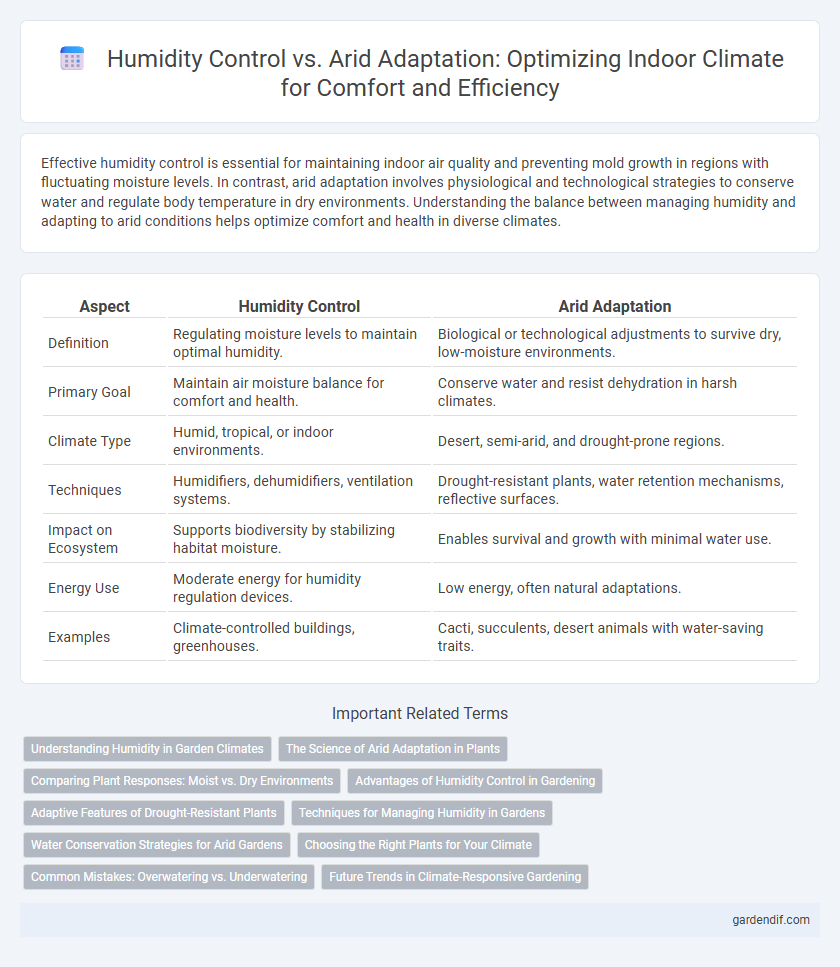
Humidity Control vs Arid Adaptation Illustration
Effective humidity control is essential for maintaining indoor air quality and preventing mold growth in regions with fluctuating moisture levels. In contrast, arid adaptation involves physiological and technological strategies to conserve water and regulate body temperature in dry environments. Understanding the balance between managing humidity and adapting to arid conditions helps optimize comfort and health in diverse climates.
Table of Comparison
| Aspect | Humidity Control | Arid Adaptation |
|---|---|---|
| Definition | Regulating moisture levels to maintain optimal humidity. | Biological or technological adjustments to survive dry, low-moisture environments. |
| Primary Goal | Maintain air moisture balance for comfort and health. | Conserve water and resist dehydration in harsh climates. |
| Climate Type | Humid, tropical, or indoor environments. | Desert, semi-arid, and drought-prone regions. |
| Techniques | Humidifiers, dehumidifiers, ventilation systems. | Drought-resistant plants, water retention mechanisms, reflective surfaces. |
| Impact on Ecosystem | Supports biodiversity by stabilizing habitat moisture. | Enables survival and growth with minimal water use. |
| Energy Use | Moderate energy for humidity regulation devices. | Low energy, often natural adaptations. |
| Examples | Climate-controlled buildings, greenhouses. | Cacti, succulents, desert animals with water-saving traits. |
Understanding Humidity in Garden Climates
Humidity control in garden climates is crucial for maintaining plant health by regulating moisture levels to prevent fungal diseases and promote optimal growth. Understanding relative humidity and its fluctuations enables gardeners to select appropriate irrigation methods and plant species adapted to local conditions. Implementing strategies such as mulching and ventilation enhances arid adaptation, reducing water stress and improving soil moisture retention.
The Science of Arid Adaptation in Plants
Plants in arid environments exhibit physiological and structural adaptations such as thick cuticles, reduced leaf surface area, and deep root systems to minimize water loss and maximize water uptake. Stomatal regulation plays a crucial role in controlling transpiration rates under low humidity, optimizing gas exchange while conserving moisture. Genetic adaptations enhance drought tolerance by producing osmoprotectants and heat-shock proteins, enabling survival in extreme dry climates.
Comparing Plant Responses: Moist vs. Dry Environments
Plants in moist environments regulate humidity through transpiration, maintaining optimal water balance by opening stomata during cooler parts of the day. In contrast, arid-adapted species exhibit adaptations such as thicker cuticles, reduced leaf surface area, and sunken stomata to minimize water loss in dry conditions. These divergent strategies highlight evolutionary responses to water availability, optimizing survival and growth across contrasting climates.
Advantages of Humidity Control in Gardening
Humidity control in gardening enhances plant growth by maintaining optimal moisture levels, reducing water stress, and preventing fungal diseases that thrive in excessive dampness. Controlled humidity promotes efficient nutrient uptake and improves photosynthesis, resulting in healthier, more resilient plants. It also allows for a stable indoor environment, extending the growing season and optimizing yield in greenhouses and controlled environments.
Adaptive Features of Drought-Resistant Plants
Drought-resistant plants exhibit adaptive features such as deep root systems, thick cuticles, and reduced leaf surface area to minimize water loss and maximize moisture uptake in arid environments. These plants regulate stomatal opening efficiently to balance CO2 intake with humidity control, optimizing water use efficiency during prolonged dry periods. Their cellular mechanisms include osmotic adjustment and accumulation of compatible solutes to maintain turgor pressure and metabolic function under low humidity conditions.
Techniques for Managing Humidity in Gardens
Effective humidity control in gardens relies on techniques such as mulching, which retains soil moisture and prevents excessive evaporation, and the use of shade structures to reduce direct sunlight exposure and lower ambient humidity. Arid adaptation involves selecting drought-resistant plant species and implementing drip irrigation systems that deliver precise water amounts, minimizing humidity fluctuations. Combining these approaches enhances plant resilience and optimizes water use efficiency in both humid and arid climates.
Water Conservation Strategies for Arid Gardens
Efficient water conservation in arid gardens hinges on minimizing evaporation through humidity control techniques such as mulching and shading, which help retain soil moisture. Selecting drought-resistant plant species with deep root systems enhances water uptake and reduces irrigation needs. Implementing rainwater harvesting and drip irrigation further optimizes water use, ensuring sustainable garden maintenance in hot, dry climates.
Choosing the Right Plants for Your Climate
Selecting plants suited to your climate's humidity levels ensures optimal growth and water efficiency. Humidity control favors species that thrive in moisture-rich environments, such as ferns and tropical orchids, while arid adaptation requires drought-resistant plants like cacti and succulents. Understanding local humidity patterns helps gardeners choose vegetation that minimizes irrigation needs and maximizes resilience.
Common Mistakes: Overwatering vs. Underwatering
Overwatering in humidity control often leads to mold growth and root rot, impairing plant health in climates with high moisture levels. Conversely, underwatering during arid adaptation causes drought stress, reducing photosynthesis and stunting growth. Proper balance involves monitoring soil moisture and adjusting water supply according to specific plant species and environmental humidity conditions.
Future Trends in Climate-Responsive Gardening
Future trends in climate-responsive gardening emphasize advanced humidity control technologies to optimize plant health and water efficiency, especially in volatile weather patterns. Innovations include smart irrigation systems that adjust moisture levels based on real-time atmospheric data and soil sensors, effectively balancing humidity exposure for diverse plant species. Simultaneously, breeding and engineering of drought-tolerant plants enhance arid adaptation, enabling sustainable urban and agricultural landscapes in increasingly dry climates.
Humidity Control vs Arid Adaptation Infographic

 gardendif.com
gardendif.com